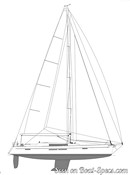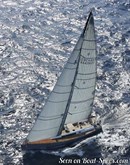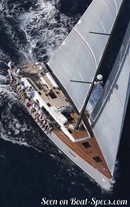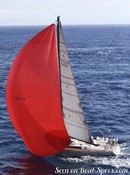Centurion 57 Deep draft
Sailboat specifications
The Centurion 57 is a 58’1” (17.7m) cruiser-racer sailboat designed by Berret Racoupeau Yachts Design (France). She is built since 2014 by Wauquiez (France). The Deep draft version offers a deeper L-shaped keel bringing extra performance especially upwind. She has been awarded "2015 - European Yacht of the Year: Luxury Cruiser".
The Centurion 57 is as well listed, on Boat-Specs.com, in Standard and Shoal draft version (see all the versions compared).
The Centurion 57 is as well listed, on Boat-Specs.com, in Standard and Shoal draft version (see all the versions compared).
Centurion 57's main features
- Model
- Centurion 57
- Version
- Deep draft
- Hull type
- Monohull
- Category
- Offshore cruiser-racer sailboat
- Sailboat builder
- Sailboat designer
- Sailboat range
- Country
- France
- Construction
- GRP (glass reinforced polyester):
- Hull: Sandwich balsa fiberglass polyester (vacuum infusion)
- Deck: Sandwich balsa fiberglass polyester (vacuum infusion) - First built hull
- 2014
- Last built hull
- Still in production
- Award(s)
- 2015: European Yacht of the Year: Luxury Cruiser
- Appendages
- Keel : L-shaped keel (with bulb)
- Helm
- Twin helm wheels
- Rudder
- Single spade rudder
- Unsinkable
- No
- Trailerable
- No
- EC design categoryiThe CE design category indicates the ability to cope with certain weather conditions (the sailboat is designed for these conditions)
A: Wind < force 9, Waves < 10m
B: Wind < force 8, Waves < 8m
C: Wind < force 6, Waves < 4m
D: Wind < force 4, Waves < 0,5m - A
- Standard public price ex. VAT (indicative only)
- About660 000 €(2020)
Centurion 57's main dimensions
- Hull length
- 58’ 1”17.7 m
- Waterline length
- 50’ 7”15.42 m
- Beam (width)
- 16’ 2”4.95 m
- Draft
- 8’ 2”2.5 m
- Light displacement (MLC)
- 49604 lb22500 kg
- Ballast weight
- 14088 lb6390 kg
- Ballast type
- Cast iron
Centurion 57's rig and sails
- Upwind sail area
- 1636 ft²152 m²
- Downwind sail area
- 3068 ft²285 m²
- Mainsail area
- 936 ft²87 m²
- Genoa area
- 700 ft²65 m²
- Asymmetric spinnaker area
- 2131 ft²198 m²
- Code 0 area
- 1055 ft²98 m²
- IiFore triangle height (from mast foot to fore stay top attachment)
- 67’ 7”20.6 m
- JiFore triangle base (from mast foot to bottom of forestay)
- 20’ 10”6.33 m
- PiMainsail hoist measurement (from tack to head)
- 65’19.8 m
- EiMainsail foot measurement (from tack to clew)
- 24’ 7”7.5 m
- Rigging type
- Sloop Marconi 19/20
- Mast configuration
- Keel stepped mast
- Rotating spars
- No
- Number of levels of spreaders
- 3
- Spreaders angle
- Swept-back
- Spars construction
- Aluminum spars
- Standing rigging
- Dyform discontinuous
Centurion 57's performances
- Upwind sail area to displacementiThe ratio sail area to displacement is obtained by dividing the sail area by the boat's displaced volume to the power two-thirds.
The ratio sail area to displacement can be used to compare the relative sail plan of different sailboats no matter what their size.
Upwind: under 18 the ratio indicates a cruise oriented sailboat with limited performances especially in light wind, while over 25 it indicates a fast sailboat. - 205 ft²/T19.07 m²/T
- Downwind sail area to displacementiThe ratio sail area to displacement is obtained by dividing the sail area by the boat's displaced volume to the power two-thirds.
The ratio sail area to displacement can be used to compare the relative sail plan of different sailboats no matter what their size. - 385 ft²/T35.76 m²/T
- Displacement-length ratio (DLR)iThe Displacement Length Ratio (DLR) is a figure that points out the boat's weight compared to its waterline length. The DLR is obtained by dividing the boat's displacement in tons by the cube of one one-hundredth of the waterline length (in feet).
The DLR can be used to compare the relative mass of different sailboats no matter what their length:
a DLR less than 180 is indicative of a really light sailboat (race boat made for planning), while a DLR greater than 300 is indicative of a heavy cruising sailboat. - 174
- Ballast ratioiThe Ballast ratio is an indicator of stability; it is obtained by dividing the boat's displacement by the mass of the ballast. Since the stability depends also of the hull shapes and the position of the center of gravity, only the boats with similar ballast arrangements and hull shapes should be compared.
The higher the ballast ratio is, the greater is the stability. - 28 %
- Critical hull speediAs a ship moves in the water, it creates standing waves that oppose its movement. This effect increases dramatically the resistance when the boat reaches a speed-length ratio (speed-length ratio is the ratio between the speed in knots and the square root of the waterline length in feet) of about 1.2 (corresponding to a Froude Number of 0.35) . This very sharp rise in resistance, between speed-length ratio of 1.2 to 1.5, is insurmountable for heavy sailboats and so becomes an apparent barrier. This leads to the concept of "hull speed".
The hull speed is obtained by multiplying the square root of the waterline length (in feet) by 1.34. - 9.53 knots
Centurion 57's auxiliary engine
- Engine(s)
- 1 inboard engine
- Engine(s) power (min./max.)
- 110 HP / 150 HP
- Fuel type
- Diesel
- Fuel tank capacity
- 162.5 gal615 liters
Centurion 57's accommodations and layout
- Cockpit
- Open aft cockpit
- Cabin(s) (min./max.)
- 3 / 4
- Berth(s) (min./max.)
- 6 / 7
- Head(s) (min./max.)
- 3 / 4
- Freshwater tank capacity
- 268.1 gal1015 liters
- Holding tank capacity
- 42.3 gal160 liters
- Fridge/ice-box capacity
- 79.3 gal300 liters
- Boiler capacity
- 19.8 gal75 liters
- Galley headroom
- 6’ 7”2.02 m
Centurion 57's saloon
- Maximum headroom
- 6’ 8”2.04 m
Centurion 57's fore cabin
- Maximum headroom
- 6’ 7”2.02 m
- Berth length
- 6’ 8”2.05 m
- Berth width
- 5’ 2”1.6 m
Centurion 57's aft cabin
- Maximum headroom
- 6’ 7”2.02 m
- Berth length
- 6’ 8”2.05 m
- Berth width
- 4’ 7”1.4 m



Wauquiez Centurion 57 sailplan - - 2/14
Picture extracted from the commercial documentation © Wauquiez
Picture extracted from the commercial documentation © Wauquiez




Wauquiez Centurion 57 sailing - - 5/14
Picture extracted from the commercial documentation © Wauquiez
Picture extracted from the commercial documentation © Wauquiez


Wauquiez Centurion 57 sailing - - 6/14
Picture extracted from the commercial documentation © Wauquiez
Picture extracted from the commercial documentation © Wauquiez


Wauquiez Centurion 57 sailing - - 7/14
Picture extracted from the commercial documentation © Wauquiez
Picture extracted from the commercial documentation © Wauquiez


Wauquiez Centurion 57 sailing - - 8/14
Picture extracted from the commercial documentation © Wauquiez
Picture extracted from the commercial documentation © Wauquiez


Wauquiez Centurion 57 cockpit - - 9/14
Picture extracted from the commercial documentation © Wauquiez
Picture extracted from the commercial documentation © Wauquiez


Wauquiez Centurion 57 interior and accommodations - - 10/14
Picture extracted from the commercial documentation © Wauquiez
Picture extracted from the commercial documentation © Wauquiez


Wauquiez Centurion 57 interior and accommodations - - 11/14
Picture extracted from the commercial documentation © Wauquiez
Picture extracted from the commercial documentation © Wauquiez


Wauquiez Centurion 57 interior and accommodations - - 12/14
Picture extracted from the commercial documentation © Wauquiez
Picture extracted from the commercial documentation © Wauquiez


Wauquiez Centurion 57 interior and accommodations - - 13/14
Picture extracted from the commercial documentation © Wauquiez
Picture extracted from the commercial documentation © Wauquiez


Wauquiez Centurion 57 interior and accommodations - - 14/14
Picture extracted from the commercial documentation © Wauquiez
Picture extracted from the commercial documentation © Wauquiez
Similar sailboats that may interest you:
Sailboats
First built hull
Hull length
1988
52’ 6”16 m
2011
55’ 1”16.8 m
2002
55’ 5”16.9 m
2014
56’ 1”17.1 m
2014
58’ 1”17.7 m
2010
63’ 1”19.22 m
2005
55’16.76 m
1999
55’ 8”16.98 m
2015
58’ 2”17.75 m
2016
55’ 1”16.8 m
2000
52’ 6”16 m
2017
50’ 11”15.51 m
1990
51’ 8”15.75 m
2017
58’ 1”17.7 m
2018
57’ 2”17.44 m